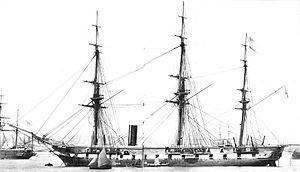HMS Topaze (1858)
 |
|
| History | |
|---|---|
|
|
|
| Name: | HMS Topaze |
| Launched: | 12 May 1858, Devonport |
| Commissioned: | 11 June 1859 |
| Decommissioned: | 28 June 1878 |
| Fate: | Sold on 14 February 1884 and broken up at Charlton |
| General characteristics | |
| Class and type: | Liffey class frigate |
| Displacement: | 3,915 tons |
| Tons burthen: | 2,659 bm |
| Length: | 235 ft |
| Propulsion: | 600 hp steam engine |
| Complement: | 515 |
| Armament: |
|
HMS Topaze was a 51-gun Liffey class wooden screw frigate of the Royal Navy. She was launched on 12 May 1858, at Devonport Dockyard, Plymouth.
Her crew assisted in the building of the Race Rocks Lighthouse in British Columbia, Canada, and laid a bronze tablet in 1868 at the Juan Fernández Islands commemorating the stay of marooned sailor Alexander Selkirk. On the same voyage, the band from HMS Topaze played for the dedication of Congregation Emanu-El, now the oldest surviving synagogue building in Canada.
The voyage to Easter Island in 1868 saw the crew remove the Moai Moai Hava and Hoa Hakananai'a and ship them to Britain, where Hoa Hakananai'a can now be seen in the British Museum.
The ship is notable for an incident when Agnes Weston came on board to plead the cause of Temperance; as she recalled in her memoire:
Topaze was sold on 14 February 1884 and broken up at Charlton.
...
Wikipedia
